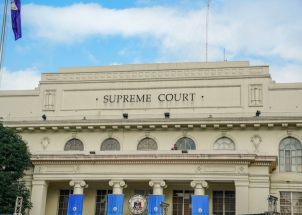Secondary evidence

January 7, 2004 | 12:00am
When can a secondary evidence or a copy of the original document be admitted to prove the contents of the original? This is the question resolved in the case of a leading credit card company (CMC).
CMC operates a credit card system through which it extends credit accommodation to its cardholders for the purchase of goods and services from its member-establishments. Among its cardholders is Teddy who was issued Mastercard No. 5423-3920-4457-7009 upon his application on Dec. 14, 1990.
Teddy used his credit card in making various purchases and was billed by CMC for those purchases for which he tendered various payments. By January 20, 1995, CMC’s statement of account showed that Teddy’s obligations stood at P191,693.25 inclusive of interest of 3.5 percent per month and service charges. When Teddy refused and failed to pay said amount despite repeated demands, CMC sued him before the Metropolitan Trial Court (MTC).
During the trial, CMC presented as principal witness its assistant manager Hermie who presented photocopies of general sales invoices or charge slips which added up to only P24,388.36. Although mere photocopies of the originals, the trial court deemed them sufficient proof of Teddy’s purchases with the use of the credit card. According to Hermie the original copy had gone to Teddy, another to the merchant and still another to CMC. He searched for the originals of CMC and requested them from the Credit Card Network (ECCN Inc.). through which they are cleared. But Hermie did not follow up the search. He just identified the signatures of Teddy on the photocopies of the sales invoices as the same as his signature in the application form.
On the basis of this evidence, the MTC rendered judgment in favor of CMC but only for the amount of P24,388.36 covered by the sales invoices and not the entire amount of its claim of P191,693.25. The Regional Trial Court (RTC) affirmed this decision in toto. But on further appeal, The Court of Appeals (CA) reversed and set aside the decisions of the MTC and RTC. According to the CA, the photocopies of the sales invoices were not competent proofs of the sales invoices or charge slips because, while the CMC was able to prove the existence of the originals by presenting photocopies, it failed to prove their due execution or to account for their loss of unavailability.
Was the CA correct?
Yes.
The original copies of the sales invoices are the best evidence to prove the alleged obligation. Photocopies thereof are mere secondary evidence. As such they are inadmissible because CMC, as offeror failed to prove the conditions of their admissibility as follows: (1) the existence and due execution of the original; (2) the loss or destruction of the original or the reason for its non-production in court; and (3) on the part of the offeror, the absence of bad faith to which the unavailability of the original can be attributed.
In this case CMC failed to prove that the original sales invoices had been lost or could not be produced in court after reasonable diligence and good faith in searching them because the originals might have been found by the Credit Card Network (ECCN Inc.). But Hermie, testifying that he had requested the originals from ECCN Inc., failed to show that he had subsequently followed up the request.
Besides, when more than one original copy exists, it must appear that all of them have been lost or destroyed or cannot be produced in court before secondary evidence can be given of any one. A photocopy may not be used without accounting for all the originals. In this case triplicates were made although the cardholder signed the invoice only once. Each of these three copies is regarded as an original in accordance with Section 4 (b) Rule 130 of the Rules of Court. CMC failed to show that all three original copies were unavailable and that due diligence had been exercised in the search for them.
Because of the inadmissibility of the photocopies in the absence of the originals, Teddy’s obligation was not established (Citibank, N.A. Mastercard vs. Efren S. Tedodoro G.R. 150905 Sept. 23, 2003).
E-mail: [email protected]
CMC operates a credit card system through which it extends credit accommodation to its cardholders for the purchase of goods and services from its member-establishments. Among its cardholders is Teddy who was issued Mastercard No. 5423-3920-4457-7009 upon his application on Dec. 14, 1990.
Teddy used his credit card in making various purchases and was billed by CMC for those purchases for which he tendered various payments. By January 20, 1995, CMC’s statement of account showed that Teddy’s obligations stood at P191,693.25 inclusive of interest of 3.5 percent per month and service charges. When Teddy refused and failed to pay said amount despite repeated demands, CMC sued him before the Metropolitan Trial Court (MTC).
During the trial, CMC presented as principal witness its assistant manager Hermie who presented photocopies of general sales invoices or charge slips which added up to only P24,388.36. Although mere photocopies of the originals, the trial court deemed them sufficient proof of Teddy’s purchases with the use of the credit card. According to Hermie the original copy had gone to Teddy, another to the merchant and still another to CMC. He searched for the originals of CMC and requested them from the Credit Card Network (ECCN Inc.). through which they are cleared. But Hermie did not follow up the search. He just identified the signatures of Teddy on the photocopies of the sales invoices as the same as his signature in the application form.
On the basis of this evidence, the MTC rendered judgment in favor of CMC but only for the amount of P24,388.36 covered by the sales invoices and not the entire amount of its claim of P191,693.25. The Regional Trial Court (RTC) affirmed this decision in toto. But on further appeal, The Court of Appeals (CA) reversed and set aside the decisions of the MTC and RTC. According to the CA, the photocopies of the sales invoices were not competent proofs of the sales invoices or charge slips because, while the CMC was able to prove the existence of the originals by presenting photocopies, it failed to prove their due execution or to account for their loss of unavailability.
Was the CA correct?
Yes.
The original copies of the sales invoices are the best evidence to prove the alleged obligation. Photocopies thereof are mere secondary evidence. As such they are inadmissible because CMC, as offeror failed to prove the conditions of their admissibility as follows: (1) the existence and due execution of the original; (2) the loss or destruction of the original or the reason for its non-production in court; and (3) on the part of the offeror, the absence of bad faith to which the unavailability of the original can be attributed.
In this case CMC failed to prove that the original sales invoices had been lost or could not be produced in court after reasonable diligence and good faith in searching them because the originals might have been found by the Credit Card Network (ECCN Inc.). But Hermie, testifying that he had requested the originals from ECCN Inc., failed to show that he had subsequently followed up the request.
Besides, when more than one original copy exists, it must appear that all of them have been lost or destroyed or cannot be produced in court before secondary evidence can be given of any one. A photocopy may not be used without accounting for all the originals. In this case triplicates were made although the cardholder signed the invoice only once. Each of these three copies is regarded as an original in accordance with Section 4 (b) Rule 130 of the Rules of Court. CMC failed to show that all three original copies were unavailable and that due diligence had been exercised in the search for them.
Because of the inadmissibility of the photocopies in the absence of the originals, Teddy’s obligation was not established (Citibank, N.A. Mastercard vs. Efren S. Tedodoro G.R. 150905 Sept. 23, 2003).
BrandSpace Articles
<
>
- Latest
- Trending
Trending
Latest
Recommended

January 28, 2025 - 2:22pm



























